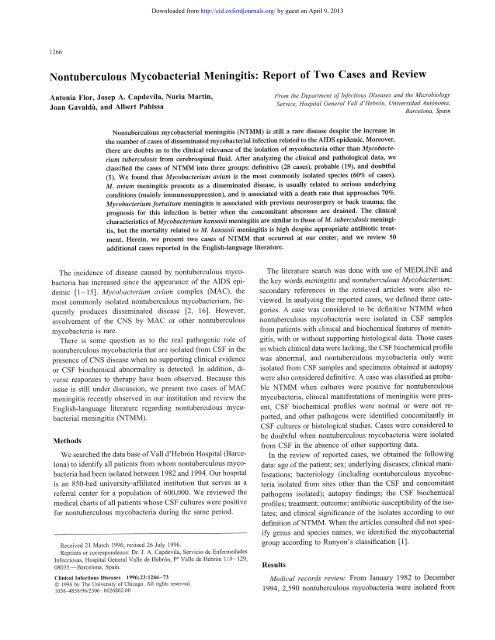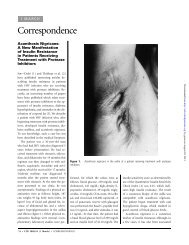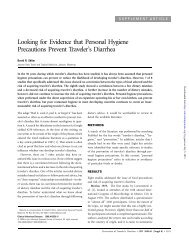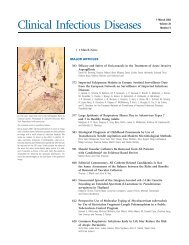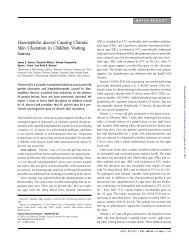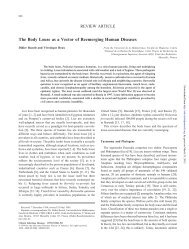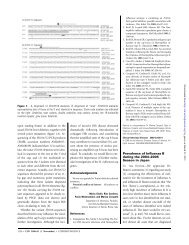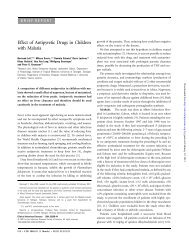Nontuberculous Mycobacterial Meningitis - Clinical Infectious ...
Nontuberculous Mycobacterial Meningitis - Clinical Infectious ...
Nontuberculous Mycobacterial Meningitis - Clinical Infectious ...
Create successful ePaper yourself
Turn your PDF publications into a flip-book with our unique Google optimized e-Paper software.
1266<br />
<strong>Nontuberculous</strong> <strong>Mycobacterial</strong> <strong>Meningitis</strong>: Report of Two Cases and Review<br />
Antonia Flor, Josep A. Capdevila, Nuria Martin,<br />
Joan Gavalda, and Albert Pahissa<br />
From the Department of <strong>Infectious</strong> Diseases and the Microbiology<br />
Service, Hospital General Vall dHebr6n, Universidad Aut6noma,<br />
Barcelona, Spain<br />
<strong>Nontuberculous</strong> mycobacterial meningitis (NTMM) is still a rare disease despite the increase in<br />
the number of cases of disseminated mycobacterial infection related to the AIDS epidemic. Moreover,<br />
there are doubts as to the clinical relevance of the isolation of mycobacteria other than Mycobacterium<br />
tuberculosis from cerebrospinal fluid. After analyzing the clinical and pathological data, we<br />
classified the cases of NTMM into three groups: definitive (28 cases), probable (19), and doubtful<br />
(5). We found that Mycobacterium avium is the most commonly isolated species (60% of cases).<br />
M. avium meningitis presents as a disseminated disease, is usually related to serious underlying<br />
conditions (mainly immunosuppression), and is associated with a death rate that approaches 70%.<br />
Mycobacterium fortuitum meningitis is associated with previous neurosurgery or back trauma; the<br />
prognosis for this infection is better when the concomitant abscesses are drained. The clinical<br />
characteristics of Mycobacterium kansasii meningitis are similar to those of M. tuberculosis meningitis,<br />
but the mortality related to M. kansasii meningitis is high despite appropriate antibiotic treatment.<br />
Herein, we present two cases of NTMM that occurred at our center, and we review 50<br />
additional cases reported in the English-language literature.<br />
The incidence of disease caused by nontuberculous mycobacteria<br />
has increased since the appearance of the AIDS epidemic<br />
[1-15]. Mycobacterium avium complex (MAC), the<br />
most commonly isolated nontuberculous mycobacterium, frequently<br />
produces disseminated disease [2, 16]. However,<br />
involvement of the CNS by MAC or other nontuberculous<br />
mycobacteria is rare.<br />
There is some question as to the real pathogenic role of<br />
nontuberculous mycobacteria that are isolated from CSF in the<br />
presence of CNS disease when no supporting clinical evidence<br />
or CSF biochemical abnormality is detected. In addition, diverse<br />
responses to therapy have been observed. Because this<br />
issue is still under discussion, we present two cases of MAC<br />
meningitis recently observed in our institution and review the<br />
English-language literature regarding nontuberculous mycobacterial<br />
meningitis (NTMM).<br />
Methods<br />
We searched the data base of Vall d'HebronHospital (Barcelona)<br />
to identify all patients from whom nontuberculous mycobacteria<br />
had been isolated between 1982 and 1994. Our hospital<br />
is an 850-bed university-affiliated institution that serves as a<br />
referral center for a population of 600,000. We reviewed the<br />
medical charts of all patients whose CSF cultures were positive<br />
for nontuberculous mycobacteria during the same period.<br />
Received 21 March 1996; revised 26 July 1996.<br />
Reprints or correspondence: Dr. J. A. Capdevila, Servicio de Enfermedades<br />
Infecciosas, Hospital General Valle de Hebron, po Valle de Hebron 119-129,<br />
08035-Barce1ona, Spain.<br />
<strong>Clinical</strong> <strong>Infectious</strong> Diseases 1996; 23:1266-73<br />
© 1996 by The University of Chicago. All rights reserved.<br />
1058-4838/96/2306-0026$02.00<br />
Downloaded from<br />
http://cid.oxfordjournals.org/ by guest on April 9, 2013<br />
The literature search was done with use of MEDLINE and<br />
the key words meningitis and non tuberculous Mycobacterium;<br />
secondary references in the retrieved articles were also reviewed.<br />
In analyzing the reported cases, we defined three categories.<br />
A case was considered to be definitive NTMM when<br />
nontuberculous mycobacteria were isolated in CSF samples<br />
from patients with clinical and biochemical features of meningitis,<br />
with or without supporting histological data. Those cases<br />
in which clinical data were lacking, the CSF biochemical profile<br />
was abnormal, and nontuberculous mycobacteria only were<br />
isolated from CSF samples and specimens obtained at autopsy<br />
were also considered definitive. A case was classified as probable<br />
NTMM when cultures were positive for nontuberculous<br />
mycobacteria, clinical manifestations of meningitis were present,<br />
CSF biochemical profiles were normal or were not reported,<br />
and other pathogens were identified concomitantly in<br />
CSF cultures or histological studies. Cases were considered to<br />
be doubtful when nontuberculous mycobacteria were isolated<br />
from CSF in the absence of other supporting data.<br />
In the review of reported cases, we obtained the following<br />
data: age of the patient; sex; underlying diseases; clinical manifestations;<br />
bacteriology (including nontubercuIous mycobacteria<br />
isolated from sites other than the CSF and concomitant<br />
pathogens isolated); autopsy findings; the CSF biochemical<br />
profiles; treatment; outcome; antibiotic susceptibility ofthe isolates;<br />
and clinical significance of the isolates according to our<br />
definition of NT MM. When the articles consulted did not specify<br />
genus and species names, we identified the mycobacterial<br />
group according to Runyon's classification [1].<br />
Results<br />
Medical records review. From January 1982 to December<br />
1994, 2,590 nontuberculous mycobacteria were isolated from
em 1996;23 (December) Nontubercu1ous <strong>Mycobacterial</strong> <strong>Meningitis</strong> 1267<br />
clinical samples in our laboratory. Of these isolates, 308<br />
(11.9%) were MAC. Between 1982 and 1989, 51 MAC isolates<br />
were recovered from 24 patients, and between 1990 and 1994,<br />
257 MAC isolates were recovered from 100 patients. Over the<br />
entire study period, only two nontuberculous mycobacterial<br />
isolates were recovered from CSF cultures.<br />
Case Reports<br />
A summary of the findings for the two patients at our center<br />
who had AIDS and disseminated MAC disease is presented in<br />
table 1. One of the patients had meningitis with hemiparesis,<br />
and she died despite institution of antimycobacterial therapy.<br />
The other patient had only persistent fever without meningism,<br />
and MAC was isolated from a culture of CSF. This patient<br />
received therapy with isoniazid, rifampin, and ciprofloxacin,<br />
but he died 2 months later.<br />
Literature review. We identified 50 cases of NTMM in the<br />
English-language literature. The main characteristics of these<br />
cases are shown in table 1 [8, 17 -37], and their relations with<br />
underlying conditions are shown in table 2. Of the 50 cases<br />
of reported NTMM, we determined that 27 were definitive<br />
meningitis, 18 were probable meningitis, and five were doubtful<br />
meningitis according to the criteria described. The first case at<br />
our center was defined as definitive meningitis, and the second<br />
was defined as doubtful meningitis.<br />
Discussion<br />
Isolation of a single colony of Mycobacterium tuberculosis<br />
is always clinically significant; however, other species of my cobacteria<br />
may be pathogens or simply contaminants. Assessment<br />
of the pathogenicity of mycobacteria is aided by the following<br />
data: repeated isolation of the same organism; identity of the<br />
species; underlying predisposing conditions; and specimens<br />
cultured [1, 38-40]. Isolation of nontuberculous mycobacteria<br />
from a sterile fluid such as CSF is a significant finding; thus,<br />
we based our review on this finding.<br />
The species of nontuberculous mycobacteria reported to<br />
cause meningitis include the four groups of the Runyon classification<br />
[1]. There is considerable variation in the incidence of<br />
these species: 31 (60%) of the 52 cases were caused by MAC,<br />
nine (17%) were caused by mycobacteria from Runyon group<br />
II, six (11.5%) were caused by Mycobacterium kansasii, and<br />
six (11.5%) were caused by Mycobacterium fortuitum.<br />
NTMM occurred in all age-groups; however, the relative<br />
incidence of each species was more evenly distributed among<br />
children than among the total population of patients: 29% (4<br />
of 14 isolates) were MAC, 29% (4 of 14) were M kansasii,<br />
29% (4 of 14) were from Runyon group II, and 14% (2 of 14)<br />
were M fortuitum. The majority of cases in adults have been<br />
caused by MAC.<br />
It is interesting to note that most ofthe children with NTMM<br />
(all except one with lymphoma [37]) have been immunocompe-<br />
Downloaded from<br />
http://cid.oxfordjournals.org/ by guest on April 9, 2013<br />
tent. Three had underlying predisposing conditions including<br />
chronic otitis and mastoiditis [20, 31] and a CSF shunt for<br />
hydrocephalus [28].<br />
Since the appearance of the AIDS epidemic, the number of<br />
cases of MAC meningitis has increased [7, 9, 21, 24-26]; 22<br />
(71 %) ofthe 31 reported cases occurred in patients with AIDS.<br />
We found enough data to classify these cases: 18 were considered<br />
definitive; three, probable; and one, doubtful. In most (18<br />
of 22) of these patients, MAC caused disseminated disease<br />
before invading the meninges.<br />
Autopsy was performed in four cases and disclosed extensive<br />
involvement of the liver, spleen, lymph nodes, bone marrow,<br />
and gastrointestinal tract in each case. CNS involvement was<br />
usually characterized by low-grade inflammation and the presence<br />
of perivascular lesions, poorly formed granulomas without<br />
giant cells, and numerous acid-fast bacilli. There was no evidence<br />
of other opportunistic infections.<br />
The clinical findings varied, but all patients had a history of<br />
weight loss; one-half were febrile, and one-third had headache<br />
and altered mentation [21, 24, 26]. The CSF biochemical profiles<br />
showed moderate alterations with lymphocytosis; however,<br />
levels of glucose and protein were close to normal, perhaps<br />
because of the poor immunologic response in patients<br />
with AIDS.<br />
The two cases of MAC meningitis that we report (cases<br />
30 and 31) occurred in patients with AIDS. These patients<br />
presented with fever, weakness, somnolence, and behavioral<br />
disorders. Analysis of CSF samples showed an increased<br />
protein level and a decreased glucose level in one case and<br />
normal levels of these constituents in the other. In both cases,<br />
cultures of blood, CSF, and bone marrow were repeatedly<br />
positive for MAC.<br />
The overall death rate for patients with MAC disease has<br />
been high (77%); however, incomplete documentation makes<br />
it difficult to determine the crude death rate of meningitis due<br />
to this microorganism. The treatment administered has not been<br />
reported for a large number of patients [21,24-26], and some<br />
of the patients were lost to follow-up. In one series of 15<br />
patients with AIDS, Jacob et al. [26] found that the in-hospital<br />
death rate was 67%. This rate may indicate that MAC meningitis<br />
is a terminal event in the clinical evolution of AIDS. CNS<br />
disease caused by MAC in patients with AIDS who have no<br />
evidence of meningitis has also been reported [5, 9, 11, 14].<br />
These cases, which clearly show the pathogenicity of MAC<br />
in the CNS, are differentiated from probable or doubtful cases<br />
of infection due to other pathogens or other underlying conditions<br />
(e.g., severe necrotizing cytomegalovirus encephalitis or<br />
primary brain lymphoma) [7, 11, 14, 21] and from cases of<br />
disseminated MAC disease in which MAC is isolated from<br />
brain tissue specimens [6, 13]. In 1986, Hawkins et al. [13]<br />
reviewed postmortem culture results for patients with AIDS<br />
and disseminated MAC disease and found that cultures of brain<br />
tissue were positive in 39%, of the cases; however, in a 1989<br />
review of autopsy findings for patients with AIDS, Santamaria
Downloaded from<br />
http://cid.oxfordjournals.org/ by guest on April 9, 2013<br />
1268 Flor et al. CID 1996;23 (December)<br />
Table 1. Features of 52 cases of nontuberculous mycobacterial meningitis.<br />
NTM and other organisms<br />
Case no. Underlying <strong>Clinical</strong> findings related to isolated<br />
[reference] Age (y)/sex condition NTMM (site, no. of isolations) Autopsy findings<br />
1 [17] 291F None <strong>Meningitis</strong> MAC (CSF, 1) NA<br />
2 [18] 51F None <strong>Meningitis</strong> MAC (CSF) NA<br />
3 [18] 141M None <strong>Meningitis</strong> MAC (CSF) NA<br />
4 [19] 461F None <strong>Meningitis</strong>; mass in Cryptococcus neoformans NA<br />
posterior fossa on CT (CSF); MAC (CSF, 2)<br />
scan<br />
5 [20] lIF None <strong>Meningitis</strong> MAC (CSF) Mesenteric and tracheal<br />
nodes with caseum<br />
6 [20] 81M Chronic otitis Otitis, cervical adenitis; no MAC (CSF) NA<br />
media meningitis<br />
7 [21] 301M AIDS Dysphagia, dyspnea, CMV and MAC (CSF); Granulomata in spleen,<br />
encephalopathy MAC (sputum); bone marrow, lungs,<br />
MAC (urine) lymph nodes, adrenal<br />
glands, and brain<br />
8 [22] NA Leukemia <strong>Meningitis</strong> Escherichia coli + MAC NA<br />
(CSF)<br />
9 [23] 40/F None <strong>Meningitis</strong> MAC + Mycobacterium NA<br />
tuberculosis (CSF, 1)<br />
10 [23] 58IM Leukemia NA MAC (CSF) NA<br />
11, 12 [24] NA AIDS Meningoencephalitis MAC (CSF) NA<br />
13, 14 [25] NA AIDS <strong>Meningitis</strong> MAC (CSF) NA<br />
15-29 [26] 33 ± 4t/9M, 6F AIDS Weight loss, fever, seizures, MAC (CSF) CNS granulomata and AFB;<br />
confusion, headaches, disseminated MAC§<br />
and vomiting!<br />
30 [PRJ 26/F AIDS Meningoencephalitis, MAC (CSF), disseminated NA<br />
hemiplegia; MAC<br />
pachymeningitis on MRI<br />
31 [PRJ 361M AIDS Fever, coma, hemiplegia; MAC (CSF), disseminated NA<br />
brain abscess on CT scan MAC<br />
32 [17] 291F None <strong>Meningitis</strong>; cavity on CXR Runyon group II (CSF, 5) NA<br />
33 [17] 321F None <strong>Meningitis</strong>; cavity on CXR Runyon, group II (CSF, 2) NA<br />
34 [17] 201F None <strong>Meningitis</strong>; miliary on CXR Runyon group II (CSF, 2) NA<br />
35 [17] 81M None <strong>Meningitis</strong> Runyon group II (CSF, 2) NA<br />
36 [17] 21F None <strong>Meningitis</strong> Runyon group II (CSF, 2) NA<br />
37 [18] 18 molM None Cervical adenitis, no Runyon group II (lymph NA<br />
meningitis node); Runyon group II<br />
(CSF)<br />
38 [27] 251F Pregnancy <strong>Meningitis</strong>, pulmonary M. tuberculosis, Runyon M tuberculosis meningitis<br />
tuberculosis 1 mo before group II (CSF, 1);<br />
NTMM diagnosed M tuberculosis (sputum)<br />
39 [23] 65/M Myeloma <strong>Meningitis</strong>; infiltrate on Mycobacterium gordonae NA<br />
CXR (CSF)<br />
40 [28] 21M Hydrocephalus <strong>Meningitis</strong> M. gordonae (CSF and NA<br />
ascitic fluid)<br />
41 [26] 281M AIDS Fever, headache; infiltrate Mycobacterium fortuitum NA<br />
onCXR (CSF)<br />
42 [29] 81M None Cauda equina abscess, M. fortuitum (CSF and NA<br />
meningitis cauda equina abscess)
cm 1996;23 (December) <strong>Nontuberculous</strong> <strong>Mycobacterial</strong> <strong>Meningitis</strong> 1269<br />
Table 1. (Continued)<br />
Downloaded from<br />
http://cid.oxfordjournals.org/ by guest on April 9, 2013<br />
Antibiotic susceptibilities Classification<br />
CSF findings Treatment Outcome (result) ofNTMM<br />
NA NA Cured NA Probable<br />
"Increased cells and protein, low NA Died NA Definitive<br />
glucose"<br />
Cloudy; WBCs, 3,000/rnm3 Pen, SSZ Rapid improvement, NA Probable<br />
CSF normal<br />
WBCs, 83/rnm3 (100% lymphocytes); AmB, 5-FC*; INH + Rif Improved; spastic INH (R), PAS (R), Rif (R), Probable<br />
protein, 38 mg/dL; glucose, added gait after AmB Etb (R), Stm (R), Cyse<br />
32 mg/dL therapy (S), Etbi (S)<br />
NA NA Died after 3 d NA Probable<br />
NA NA Cured NA Doubtful<br />
NA NA Died NA Probable<br />
NA NA Died NA Probable<br />
WBCs, 4711rnm3 (13% PMNs, 84% Pen, Clm, INH, Rif Developed mild NA Probable<br />
lymphocytes); protein, 234 mg/dL; hydrocephalus<br />
glucose, 41 mg/dL<br />
NA NA Died NA Doubtful<br />
WBCs, 13/rnm3 and 15/mm3; protein NA Died NA Definitive<br />
levels increased<br />
NA NA Died NA Probable<br />
Lymphocytes, 71%; protein, 41 mg/dL NA In-hospital mortality, NA Definitive<br />
:±: 18 mg/dLt ; glucose, 54 mg/dL :±: 67%<br />
23 mg/dO<br />
WBCs, 4/rnm3; protein, 115 mg/dL; INH, Rif, Etb; Clm, Ofx, Died NA Definitive<br />
glucose, 36 mg/dL; adenosine Amik added<br />
deaminase, 1.5 UIL<br />
Normal INH, Rif, Eth Died NA Doubtful<br />
NA NA Cured NA Probable<br />
NA NA Cured NA Probable<br />
NA NA Died 3 mo later NA Probable<br />
NA NA Cured NA Probable<br />
NA NA Cured NA Probable<br />
NA NA NA NA Doubtful<br />
Xantbochromic, hypertensive INH, PAS, Stm, Prd; Miscarried; died 5 w INH (R), PAS (R) Probable<br />
Cyse added later<br />
WBCs, 1Irnm3; protein, 55 mg/dL; Oxa, Om, INH Died NA Definitive<br />
glucose, 82 mg/dL<br />
WBCs, 53/rnm3 (100% lymphocytes); INH, Stm, Etb, INHII Improved after NA Definitive<br />
protein, 500 mg/dL; glucose, 27 removal of shunt<br />
mg/dL<br />
Normal NA Cured NA Probable<br />
Cloudy; WBCs, 3,025/mm3 (77% PZA, Eth, Etbi, Km; Improved after INH (R), PAS (R), Stm Definitive<br />
PMNs); protein, 237 mg/dL; drainage of cauda drainage; residual (R), Cyse (R), Km (S),<br />
glucose, 51 mg/dL equina abscess; final motor weakness Oxa (S)<br />
tberapy with Km +<br />
Oxa
1270 Flor et al. CID 1996; 23 (December)<br />
Table 1. (Continued)<br />
Case no.<br />
[reference]<br />
Underlying <strong>Clinical</strong> findings related to<br />
NTM and other organisms<br />
isolated<br />
Age (y)/sex condition<br />
NTMM (site, no. of isolations) Autopsy findings<br />
43 [30] 19/F None <strong>Meningitis</strong> after diskectomy M. jortuitum (CSF, 2) NA<br />
44 [31] 101M Chronic otitis<br />
media<br />
45 [32]<br />
46 [33]<br />
NA<br />
161M None (back<br />
trauma)<br />
Subdural empyema, brain M. fortuitum (CSF and NA<br />
abscess, meningitis abscess)<br />
None Fever, headache M. fortuitum (CSF, 1) NA<br />
47 [8] NA AIDS Hemiplegia, malaise, fever,<br />
hypoadrenalism<br />
48 [18] 131M None <strong>Meningitis</strong>, papilledema,<br />
hemiplegia<br />
49 [34] 34/F Pregnancy<br />
50 [35] 2/F None<br />
51 [36] 9 molM None<br />
52 [37] 131M Lymphoma<br />
<strong>Meningitis</strong>, lumbar abscess M. fortuitum (CSF, lumbar NA<br />
abscess)<br />
<strong>Meningitis</strong>, peritonitis;<br />
miliary on CXR<br />
<strong>Meningitis</strong>, malaise<br />
<strong>Meningitis</strong><br />
<strong>Meningitis</strong><br />
M. kansasii (CSF) NA<br />
M. kansasii (CSF) Granulomas and caseum in<br />
lungs, hilar nodes,<br />
meninges; M. kansasii<br />
recovered from<br />
meningeal membranes<br />
M. kansasii (CSF)<br />
NA<br />
M. kansasii (CSF, 1);<br />
M. tuberculosis (CSF,<br />
3); AFB (CSF, 4)<br />
AFB (CSF); M. kansasii<br />
(CSF)<br />
M. kansasii (CSF)<br />
Miliary lesions in spleen,<br />
adrenal glands, and brain;<br />
creamy meninges;<br />
M. kansasii recovered<br />
from meningeal<br />
membranes;<br />
M. tuberculosis recovered<br />
from lymph nodes and<br />
CSF<br />
NA<br />
NOTE. AFB = acid-fast bacilli; AmB = amphotericin B; Amik = amikacin; Clm = clarithromycin; CMV = cytomegalovirus; Cpm = capreomycin; CXR<br />
= chest radiograph; Cyse = cycloserine; Dox = doxycycline; Ern = erythromycin; Eth = ethambutol; Ethi = ethionamide; Gm = gentamicin; 5-FC = flucytosine;<br />
INH = isoniazid; Km = kanamycin; MAC = Mycobacterium aviul11 complex; NA = not available; NTM = nontuberculous mycobacteria; NTMM = nontuberculous<br />
mycobacterial meningitis; Oxa = oxacillin; Ofx = ofloxacin; PAS = para-aminosalicylic acid; PCP = Pneumocytis carinii pneumonia; Pen = penicillin; PMN<br />
= polymorphonuclear cells; PR = present report; Prd = prednisone; PZA = pyrazinamide; R = resistant; Rif = rifampin; S = susceptible; Stm = streptomycin;<br />
SSZ = sulfizoxazole; Tm = tobramycin; TMP-SMZ = trimethoprim-sulfamethoxazole.<br />
[IS] reported an incidence of CNS involvement with MAC that<br />
ranged from 3% to 10%.<br />
It is difficult to draw conclusions concerning MAC meningitis<br />
in immunocompetent patients because only two cases<br />
have been well documented (cases 2 [18] and S [20], table<br />
1). Both patients were children with disease diagnosed by<br />
clinicians as "typical tuberculous meningitis" that resulted<br />
in death, and the treatments were not reported. The other<br />
cases that have been reported were probable or doubtful;<br />
three resolved with no therapy or inappropriate therapy<br />
(cases 1 [17], 6 [20], and 3 [18]), and in two of these cases,<br />
concomitant infections including tuberculosis (case 9 [23])<br />
and cryptococcosis (case 4 [19]) were present. A case of CNS<br />
Downloaded from<br />
http://cid.oxfordjournals.org/ by guest on April 9, 2013<br />
involvement with MAC in an immunocompetent patient has<br />
been reported [41].<br />
<strong>Meningitis</strong> due to organisms of Runyon group II has been<br />
associated with certain geographical areas such as Japan.<br />
Yamamoto et al. [17] described five probable cases (five of<br />
nine reported cases) that occurred in Japan before 1967.<br />
These authors did not report specific therapies or follow-up;<br />
however, the patients had a disseminated form ofthe disease,<br />
with miliary or fibrocaseous pulmonary infiltrates and meningitis<br />
and all but one of them recovered (mortality, 20%).<br />
Mycobacterium gordonae was recovered in the two cases<br />
classified as definitive meningitis. An underlying condition<br />
was present in both of the patients-a child with hydroceph-<br />
NA
cm 1996;23 (December) <strong>Nontuberculous</strong> <strong>Mycobacterial</strong> <strong>Meningitis</strong> 1271<br />
Table 1. (Continued)<br />
CSF findings<br />
WBCs, 400/mm'; protein, 20 mg/dL;<br />
glucose, 20 mg/dL<br />
WBCs, 200/mm'<br />
Normal<br />
Cloudy; WBCs, 1,085/mm'; protein<br />
and glucose levels, normal<br />
Normal<br />
Increased number of cells and protein<br />
level<br />
NA<br />
WBCs, 200/mm' (70% lymphocytes);<br />
glucose, 27 mg/dL<br />
WBCs, 70/mm' (90% PMNs); protein,<br />
500 mg/dL; glucose, 20 mg/dL<br />
Protein, 60 mg/dL; glucose, 18 mg/dL<br />
Treatment<br />
INH, Rif, Eth, Stm;<br />
laminectomy and Dox<br />
Em, INH, Km, and partial<br />
resection of abscess;<br />
Dox, Ethi, and<br />
intrathecal Amik added<br />
None<br />
Pen, TMP-SMZ, Gm;<br />
INH and drainage of<br />
abscess and fistula<br />
INH, Rif, Eth<br />
" Antituberculous<br />
therapy"<br />
Pen, Strn, PAS<br />
Pen, sulfonamides, Clm,<br />
Strn, INH, cortisone<br />
"Antituberculous<br />
therapy"<br />
INH, Rif, PZA, Prd<br />
Outcome<br />
Infection persisted;<br />
improved after<br />
laminectomy<br />
Improved after<br />
intrathecal therapy<br />
Cured<br />
Improved<br />
Progressive lethargy;<br />
died of PCP<br />
* Given for 79 days.<br />
tMean ± SD.<br />
I Fifteen patients had weight loss, eight had fever, two had seizures, four had confusion, and five had headaches and vomiting.<br />
§ Autopsy was performed in three cases.<br />
II Given for 1 year, then given again for 5 years.<br />
alus (case 40 [28]) and an adult with myeloma (case 39<br />
[23]). The first patient was cured by removal of an infected<br />
derivative shunt; the other patient, who was treated with<br />
aminoglycosides and isoniazid, died.<br />
<strong>Meningitis</strong> due to M. fortuitum has been clearly documented<br />
(four definitive cases ofNTMM) and related to previous CNS<br />
surgery and trauma, and a neurocutaneous fistula that lasts for<br />
years has been described in these cases; drainage and/or removal<br />
of a foreign body has been demonstrated to be the best<br />
therapy. Intrathecal treatment with aminoglycosides has also<br />
been described [31]. Of the patients with M. fortuitum meningitis,<br />
only one died (this patient also had AIDS). Since abscesses<br />
are frequently present in cases of M. fortuitum meningitis, it<br />
Downloaded from<br />
http://cid.oxfordjournals.org/ by guest on April 9, 2013<br />
Died<br />
Died 5 weeks after<br />
laparotomy<br />
Died after 5 d<br />
Died<br />
Died after 7 d<br />
Antibiotic susceptibilities<br />
(result)<br />
Cpm (S), Dox (S)<br />
Amik (S), Km (R), Dox (R)<br />
NA<br />
Amik (S), Tm (S), Dox (S),<br />
INH (R), TMP-SMZ (R),<br />
Strn (R)<br />
NA<br />
NA<br />
NA<br />
INH (R), PAS (R)<br />
NA<br />
NA<br />
Classification<br />
ofNTMM<br />
Definitive<br />
Definitive<br />
Doubtful<br />
Definitive<br />
Probable<br />
Definitive<br />
Probable<br />
Probable<br />
Definitive<br />
Definitive<br />
is not surprising that the CSF biochemical findings in these<br />
cases generally include a predominance of polymorphonuclear<br />
cells.<br />
The severity of meningitis due to M. kansasii and the<br />
associated high mortality are striking. Of the six cases found<br />
in the literature, three were definitive (case 48 [18], case 51<br />
[36], and case 52 [37]; table 1), and three were probable<br />
(case 47 [8], case 49 [34] and case 50 [35]) by our definition.<br />
M. kansasii causes disseminated disease that is similar to<br />
meningitis due to M. tuberculosis. Until culture results are<br />
available, tuberculous meningitis is initially suspected in<br />
these cases when the CSF biochemical profile is consistent<br />
with lymphocytic meningitis. In the two cases of M. kansasii
1272 Flor et al. CID 1996;23 (December)<br />
Table 2. <strong>Mycobacterial</strong> species isolated among 52 patients with<br />
nontuberculous mycobacterial meningitis and predisposing underlying<br />
conditions.<br />
Mycobacterium isolate recovered<br />
Underlying Runyon<br />
condition MAC group II Mfortuitum M kansasii<br />
None 6 7 3 4<br />
Chronic otitis media 0 1 0<br />
Hematologic disease 2 0<br />
AIDS 21 0 I I<br />
Hydrocephalus 0 I 0 0<br />
Back trauma 0 0 0<br />
Neurosurgery 0 0 0<br />
NOTE. MAC = Mycobacterium avium complex.<br />
meningitis in which autopsies were performed, caseous granulomata<br />
were found in the patients' lungs and meninges.<br />
Despite institution of antituberculous therapy, all of the patients<br />
died.<br />
The majority ofNTMM cases present as lymphocytic meningitis.<br />
The CSF is normal or close to normal in patients with<br />
AIDS, and polymorphonuclear cells predominate in the CSF<br />
of patients with meningitis due to M. fortuitum. In all but two<br />
cases, direct smears of CSF for acid-fast bacilli were negative<br />
for mycobacteria.<br />
Concomitant pathogens were isolated in six (11 %) ofthe 52<br />
cases of NTMM. We consider these cases to be mixed infections<br />
and have classified them as probable NTMM. The combined<br />
isolates recovered were M. tuberculosis and a Runyon<br />
group II mycobacterium (case 38 [27], table 1), M. tuberculosis<br />
andM. kansasii (case 50 [35]), M. tuberculosis and MAC (case<br />
9 [23]), Cryptococcus neoformans and MAC (case 4 [19]),<br />
cytomegalovirus and MAC (case 7 [21]), and Escherichia coli<br />
and MAC (case 8 [22]).<br />
NTMM is frequently associated with immunosuppression:<br />
the incidence of immunosuppression in these 52 cases was 54%<br />
(28 cases). Among the immunosuppressed patients, AIDS was<br />
the most common underlying condition (24 [46%] of the 52<br />
patients). However, NTMM has also been reported in association<br />
with other immunosuppressive states (e.g., hematologic<br />
malignancy and immunosuppression due to treatment with corticoid<br />
drugs): two (8%) of these 24 cases were due to MAC<br />
(cases 8 [22] and 10 [23]), one was due to M. kansasii (case<br />
52 [37]), and one was due to M. gordonae (case 39 [23]). It<br />
is surprising that NTMM has not been observed in patients<br />
receiving hemodialysis or in transplant recipients even though<br />
mycobacterial disease is a well-recognized complication under<br />
such circumstances [15, 23, 42, 43].<br />
In summary, nontubercu10us mycobacterial microorganisms<br />
are able to cause meningitis, and when these organisms are<br />
isolated in cultures of CSF, they should not routinely be assumed<br />
to be contaminants. M. avium is the most commonly<br />
Downloaded from<br />
http://cid.oxfordjournals.org/ by guest on April 9, 2013<br />
isolated species in patients with NTMM, especially since the<br />
beginning of the AIDS epidemic. M. fortuitum meningitis is<br />
clearly associated with previous neurosurgery or spinal trauma<br />
and with chronic infection; the prognosis is good when the<br />
concomitant abscess is drained. The clinical characteristics of<br />
patients with M. kansasii meningitis are similar to those of<br />
patients with tuberculous meningitis, but mortality due to<br />
M. kansasii is higher despite adequate therapy.<br />
Acknowledgment<br />
The authors thank Celine L. Cavallo for her editorial assistance.<br />
References<br />
1. Horowitz EA, Sanders WE Jr. Other mycobacterium species. In: Mandell<br />
GL, Bennett JE, Dolin R, eds. Mandell, Douglas and Bennett's principles<br />
and practice of infectious diseases. 4th ed. New York: Churchill<br />
Livingstone, 1995:2264-73.<br />
2. Havlir DV, Ellner JJ. Mycobacterium avium complex. In: Mandell GL,<br />
Bennett JE, Dolin R, eds. Mandell, Douglas and Bennett's principles and<br />
practice of infectious diseases. 4th ed. New York: Churchill Livingstone,<br />
1995:2250-64.<br />
3. Masur H, Michelis MA, Wormser G, et al. Opportunistic infection in a<br />
previously healthy woman. Initial manifestations of a communityacquired<br />
cellular immunodeficiency. Ann Intern Med 1982;97:533-9.<br />
4. Greene JB, Sidhu G, Lewin S, et al. Mycobacterium avium complex: a<br />
cause of disseminated life-threatening infection in homosexuals and<br />
drug abusers. Ann Intern Med 1982;97:539-46.<br />
5. Snider WD, Simpson DM, Nielsen S, Gold JWM, Metroka CE, Posner JB.<br />
Neurological complications of acquired immune deficiency syndrome:<br />
analysis of 50 patients. Ann Neuro11983; 14:403-18.<br />
6. Elliot JL, Hoppes WL, Platt MS, Thomas JG, Patel IP, Gansar A. The<br />
acquired immunodeficiency syndrome and Mycobacterium avium-intracellulare<br />
bacteremia in a patient with hemophilia. Ann Intern Med 1983;<br />
98:290-3.<br />
7. Reichert CM, O'Leary TJ, Levens DL, Sirnrell CR, Macher AM. Autopsy<br />
pathology in the acquired immune deficiency syndrome. Am J Pathol<br />
1983; 112:357 -82.<br />
8. Kopple BS, Wormser GP, Tuchman AJ, Maayan S, Hewlett D Jr, Daras M.<br />
Central nervous system involvement in patients with acquired immune<br />
deficiency syndrome (AIDS). Acta Neurol Scand 1985;71:337-53.<br />
9. Levy RM, Bredesen DE, Rosembem ML. Neurological manifestations of<br />
the acquired immunodeficiency syndrome (AIDS): experience at UCSF<br />
and review of the literature. J Neurosurg 1985; 62:475-95.<br />
10. Maayan S, Wormser G, Hewlett D, et al. Acquired immunodeficiency<br />
syndrome (AIDS) in an economically disadvantaged population. Arch<br />
Intern Med 1985; 145:1607-12.<br />
II. Anders K, Steinsapir KD, Iverson DJ, et al. Neuropathological findings<br />
in the acquired immunodeficiency syndrome (AIDS). Clin Neuropathol<br />
1986;5:1-20.<br />
12. Helwelg-Larsen S, Jakobsen J, Boesen F, Arlien-S0borg P. Neurological<br />
complications and concomitants of AIDS. Acta Neurol Scand 1986;74:<br />
467-74.<br />
13. Hawkins CC, Gold JWM, Whimbey E, et al. Mycobacterium avium complex<br />
in patients with the acquired immunodeficiency syndrome. Ann<br />
Intern Med 1986; 105:184-8.<br />
14. Henin D, Duyckaerts C, Chaunu MP, et al. Etude neuropathologique de<br />
31 cas de syndrome d'immuno-depression acquise. Rev Neurol (paris)<br />
1987; 143:631-42.<br />
15. Santamaria JM. <strong>Meningitis</strong> por micobacterias no tuberculosas. Enferm<br />
Infecc Microbiol Clin 1989;7:329-31.
cm 1996;23 (December) <strong>Nontuberculous</strong> <strong>Mycobacterial</strong> <strong>Meningitis</strong> 1273<br />
16. Schonell ME, Crofton JW, Stuart AE, Wallace A. Disseminated infection<br />
with Mycobacterium avium: part I -clinical features, treatment and<br />
pathology. Tubercle 1968;49:12-15.<br />
17. Yamamoto M, Sudo K, Taga M, Hibino S. A study of diseases caused by<br />
atypical mycobacteria in Japan. Am Rev Respir Dis 1967;96:779-87.<br />
18. Lincoln EM, Gilbert LA. Disease in children due to Mycobacteria other<br />
than Mycobacterium tuberculosis. Am Rev Respir Dis 1972; 105:683-<br />
714.<br />
19. Gentry RH, Farrar WE Jr, Mahvi TA, Prevost AE, Gionis TA. Simultaneous<br />
infection of the central nervous system with Cryptococcus neoformans<br />
and Mycobacterium intracellulare. South Med J 1977;70:<br />
865-8.<br />
20. Kotian M, Sarvamangala IN, Venkatesh A, Achyntha KN, Shivananda<br />
PG. Chromophobic mycobacterial meningitis. Indian Journal of Tuberculosis<br />
1981;38:140-2.<br />
21. Zakowski P, Fligiel S, Berlin GW, Johnson L Jr. Disseminated Mycobacterium<br />
avium-intracellulare infection in homosexual men dying of acquired<br />
immunodeficiency. JAMA 1982;248:2980-2.<br />
22. Smolyanskaya AZ, Agafonov VA, Dronova OM, Makarevich NM. Bacterial<br />
meningitis caused by Escherichia coli and Mycobacterium avium<br />
in acute myeloblastic lenkemia [in Russian]. Klin Med (Mosk) 1983;<br />
61(4):81-3.<br />
23. Klein NC, Damsker B, Hirschman SZ. <strong>Mycobacterial</strong> meningitis. Retrospective<br />
analysis from 1970 to 1983. Am J Med 1985; 79:29-34.<br />
24. Levy RM, Bredesen DE. Central nervous system dysfunction in acquired<br />
immunodeficiency syndrome. J Acquir Immune Defic Syndr 1988; I:<br />
41-64.<br />
25. Perriens JR, Mussa M, Luabeya MK, et al. Neurological complications of<br />
HIV -I seropositive internal medicine inpatients in Kinshasa, Zaire. J<br />
Acquire Immune Defic Syndr 1992;5:333-40.<br />
26. Jacob CN, Henein SS, Heurich DE, Kamholz S. <strong>Nontuberculous</strong> mycobacterial<br />
infection of the central nervous system in patients with AIDS.<br />
South Med J 1993;86:638-40.<br />
27. Cucchiani A, Fiorino A, Nikolajnk R. Mycobacterias atipicas de origen<br />
humano. Rev Asoc Med Argent 1964;78:66.<br />
28. Gonzales EP, Crosby RMN, Walker SH. Mycobacterium aquae infection<br />
in a hydrocephalic child (Mycobacterium aquae meningitis). Pediatrics<br />
1971;48:974-7.<br />
Downloaded from<br />
http://cid.oxfordjournals.org/ by guest on April 9, 2013<br />
29. Hand WL, Sanford JP. Mycobacterium fortuitum-a human pathogen.<br />
Ann Intern Med 1970;73:971-7.<br />
30. Dalovisio JR, Pankey GA. Problems in diagnosis and therapy of Mycobacterium<br />
fortuitum infections. Am Rev Respir Dis 1978; 117:625-30.<br />
31. Dalovisio JR, Pankey GA, Wallace RJ, Jones DB. <strong>Clinical</strong> usefulness of<br />
amikacin and doxycycline in the treatment of infection due to Mycobacteriumfortuitum<br />
and Mycobacterium chelonei. Rev Infect Dis 1981;3:<br />
1068-74.<br />
32. Wallace RJ Jr, Swenson JM, Silcox VA, Good RC, Tschen JA, Stone MS.<br />
Spectrum of disease due to rapidly growing mycobacteria. Rev Infect<br />
Dis 1983;5:657-79.<br />
33. Santamaria-JaUregui JJ, Sanz-Hospital J, Berenguer J, Muiioz D, Gomez<br />
Mampaso E, Bouza E. <strong>Meningitis</strong> caused by Mycobacteriumfortuitum.<br />
Am Rev Respir Dis 1984; 130:136-7.<br />
34. Wood LE, Buhler VB, Pollak A. Human infection with the "yellow"<br />
acid-fast bacillus: a report of fifteen additional cases. Am Rev Tuberc<br />
1956;73:917-29.<br />
35. Huempfter HR, Kingsolver WR, Deuschle KW. Tuberculous meningitis<br />
caused by both Mycobacterium tuberculosis and atypical mycobacteria.<br />
Am Rev Respir Dis 1966;94:612.<br />
36. Chan KE, Pathmanathan T. <strong>Meningitis</strong> due to atypical mycobacteria. Med<br />
J Malaya 1961; 15:113-6.<br />
37. Kumar L, Shanta V. <strong>Meningitis</strong> due to Mycobacterium kansasii in non<br />
Hodgkin's lymphoma [letter]. N Z Med J 1989; 102:516.<br />
38. Wolinsky E. When is an infection disease? [editorial]. Rev Infect Dis<br />
1981;3:1025-7.<br />
39. Martin Casabona N, Gonzruez Fuente T, Fernandez Perez F. Micobacteriosis:<br />
presentacion de 38 casos. Med Clin (Barc) 1985;84:651-4.<br />
40. Wolinsky E. <strong>Nontuberculous</strong> mycobacteria and associated diseases. Am<br />
Rev Respir Dis 1979; 119:107-59.<br />
41. UJdry P A, Bogousslavsky J, Regli F, Chave JP, Beer V. Chronic Mycobacterium<br />
avium complex infection of the central nervous system in a<br />
nonimmunosuppressed woman. Eur NeuroI1992;32:285-8.<br />
42. Hooper DC, Pruitt AA, Rubin RH. Central nervous system infection in<br />
the chronically immunosuppressed. Medicine (Baltimore) 1982;61:<br />
166-88.<br />
43. Bolan G, Reingold AL, Carson LA, et al. Infections with Mycobacterium<br />
chelonei in patients receiving dialysis and using processed hemodialyzers.<br />
J Infect Dis 1985; 5: 10 13 - 9.


